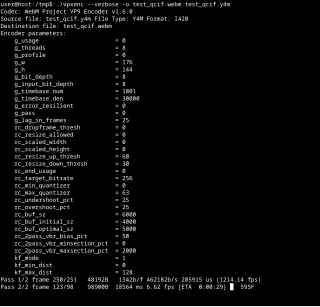Theora is a free lossy video compression format. It is developed by the Xiph.Org Foundation and distributed without licensing fees alongside their other free and open media projects, including the Vorbis audio format and the Ogg container.
The enhanced versatile disc (EVD) is an optical-medium-based digital audio/video format, developed by Beijing E-World, as a rival to the DVD to avoid the high royalty costs associated with the DVD format. Its development was supported by the Chinese government. While it was intended to replace the DVD standard in China by 2008, the format had failed to gain traction and ultimately faded into obsolescence.
On2 TrueMotion VP6 is a proprietary lossy video compression format and video codec. It is an incarnation of the TrueMotion video codec, a series of video codecs developed by On2 Technologies. This codec is commonly used by Adobe Flash, Flash Video, and JavaFX media files.

VLC media player is a free and open-source, portable, cross-platform media player and streaming media server developed by the VideoLAN project. VLC is available for desktop operating systems and mobile platforms, such as Android, iOS, Tizen, Windows 10 Mobile and Windows Phone. VLC is also available on digital distribution platforms such as Apple's App Store, Google Play and Microsoft Store.

On2 Technologies, formerly known as The Duck Corporation, was a small publicly traded company, founded in New York City in 1992 and headquartered in Clifton Park, New York, that designed video codec technology. It created a series of video codecs called TrueMotion.
Flash Video is a container file format used to deliver digital video content over the Internet using Adobe Flash Player version 6 and newer. Flash Video content may also be embedded within SWF files. There are two different video file formats known as Flash Video: FLV and F4V. The audio and video data within FLV files are encoded in the same manner as they are within SWF files. The F4V file format is based on the ISO base media file format and is starting with Flash Player 9 update 3. Both formats are supported in Adobe Flash Player and developed by Adobe Systems. FLV was originally developed by Macromedia.
In the early 2000s, Flash Video used to be the de facto standard for web-based streaming video. Notable users of it include Hulu, VEVO, Yahoo! Video, metacafe, Reuters.com, and many other news providers.
PureVideo is Nvidia's hardware SIP core that performs video decoding. PureVideo is integrated into some of the Nvidia GPUs, and it supports hardware decoding of multiple video codec standards: MPEG-2, VC-1, H.264, and HEVC. PureVideo occupies a considerable amount of a GPU's die area and should not be confused with Nvidia NVENC. In addition to video decoding on chip, PureVideo offers features such as edge enhancement, noise reduction, deinterlacing, dynamic contrast enhancement and color enhancement.

VP8 is an open and royalty free video compression format owned by Google and created by On2 Technologies as a successor to VP7.
The HTML5 specification introduced the video element for the purpose of playing videos, partially replacing the object element. HTML5 video is intended by its creators to become the new standard way to show video on the web, instead of the previous de facto standard of using the proprietary Adobe Flash plugin, though early adoption was hampered by lack of agreement as to which video coding formats and audio coding formats should be supported in web browsers.

WebM is an audiovisual media file format.
It is primarily intended to offer a royalty-free alternative to use in the HTML5 video and the HTML5 audio elements. It has a sister project WebP for images. The development of the format is sponsored by Google, and the corresponding software is distributed under a BSD license.

libvpx is a free software video codec library from Google and the Alliance for Open Media (AOMedia). It serves as the reference software implementation for the VP8 and VP9 video coding formats, and for AV1 a special fork named libaom that was stripped of backwards compatibility.

WebP is an image format employing both lossy and lossless compression. It is currently developed by Google, based on technology acquired with the purchase of On2 Technologies.

x265 is a library for encoding video into the High Efficiency Video Coding (HEVC/H.265) video compression format that was developed and standardized by the ISO/IEC MPEG and ITU-T VCEG. x265 is offered under either version 2 of the GNU General Public License (GPL) or a commercial license, similar to the x264 project.
Sorenson Media was an American software company specializing in video encoding technology. Established in December 1995 as Sorenson Vision, the company developed technology which was licensed and ultimately acquired from Utah State University. The company first announced its codec at a developer’s preview at MacWorld Expo in January 1997.
The Mali series of graphics processing units (GPUs) are semiconductor intellectual property cores produced by ARM Holdings for licensing in various ASIC designs by ARM partners.

VP9 is an open and royalty-free video coding format developed by Google.
The Alliance for Open Media (AOMedia) is a non-profit industry consortium for the development of open, royalty-free technology for multimedia delivery headquartered in Wakefield, Massachusetts, USA.
It adopts the principles of the development of open web standards for the creation of video standards that can serve as royalty-free alternatives to the hitherto dominant standards of the Moving Picture Experts Group (MPEG) and the related business model that exploits intellectual property through patent royalties and became associated with financial uncertainties, especially for internet companies and innovators.

AOMedia Video 1 (AV1) is an open, royalty-free video coding format designed for video transmissions over the Internet. It was developed by the Alliance for Open Media (AOMedia), a consortium of firms from the semiconductor industry, video on demand providers, video content producers, software development companies and web browser vendors, founded in 2015. The AV1 bitstream specification includes a reference video codec. It succeeds VP9. It can have 20% higher data compression than VP9 or HEVC/H.265 from the Moving Picture Experts Group and about 50% higher than the widely used AVC.









